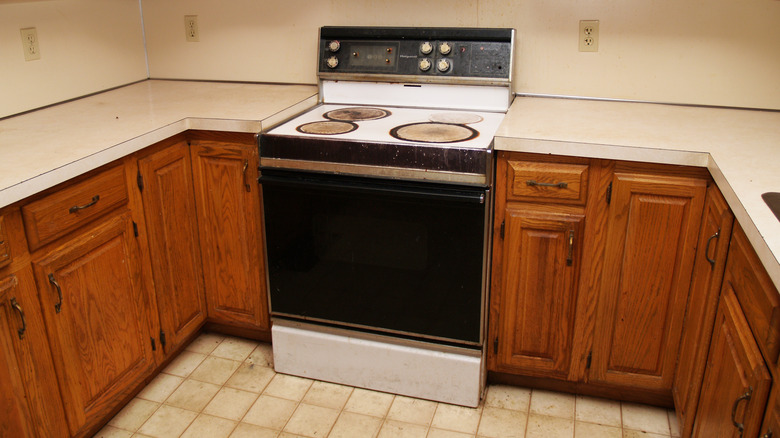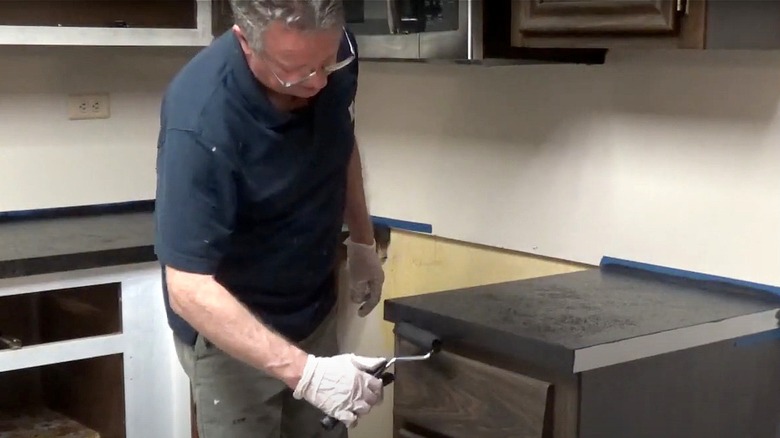Resurfacing Laminate Countertops: DIY Or Call In The Pros?
While quartz or soapstone might be the defining detail of your dream kitchen, laminate countertops are still a reality in many homes. Available in an extremely wide variety of colors and styles, laminate remains a popular choice because it's extremely budget-friendly and relatively low maintenance. But over time, scratches from food prep or abrasive cleaners, moisture from spills, and heat from hot pans can lead to unsightly damage. According to Carmine Argano, Owner of Creative Design Ceramic Tile & Bath, resurfacing laminate countertops yourself can be a cost-effective approach especially if you want a totally customized look, but for cleaner results and the most durable finish you'll want to call in the pros.
"Most laminate countertops need resurfacing every 10–15 years, but that can vary based on usage," Argano told House Digest during an exclusive interview. If you have a high traffic kitchen where your countertops frequently see hot pans or harsh cleaners, the kitchen remodeling expert said you'll need to resurface them much sooner. On the other hand, if your laminate countertops are located in low traffic areas, like a laundry room or basement kitchen, they may not show wear and tear for a couple of decades. "Moisture damage, bubbling, edge peeling, and deep scratches are all signs that it's time," Argano explained. Whether you opt to DIY or hire a professional to resurface your laminate countertops, he said the process is largely the same: "Resurfacing can mean repainting, applying a new laminate sheet, or using an epoxy coating."
DIY is ideal if you want a quick fix, but professional resurfacing is more durable
"DIY resurfacing is ideal for homeowners on a tight budget," Carmine Argano said during his exclusive interview with House Digest. Unlike hiring a contractor or swapping your outdated laminate countertops for a trendier alternative, "materials like paint kits, bonding primers, or epoxy coatings typically cost under $150." He added that professional resurfacing typically starts at twice that price, and could be $800 or more depending on the overall condition, desired finish, and total square footage. "If you're preparing your home for sale, updating a rental property, or just want a temporary aesthetic upgrade without major investment, DIY resurfacing is a practical solution that gives decent results for short-term needs," he said.
If you're more worried about durability than expense, Argano cautioned against resurfacing countertops yourself: "Professionals use commercial-grade products that aren't typically sold to homeowners." In his experience, DIY finishes just don't last as long. "Long-term durability depends on meticulous technique and aftercare," he said. Along with using products designed to last, professional tools and experience make a big difference in the final finish. "A good pro can make the counter look nearly factory-finished, especially when matching edges and sealing transitions," the expert explained.
Argano added that you should expect a steep learning curve and time-intensive process if you decide to go it alone. "DIY resurfacing isn't a quick project," he emphasized. The kitchen remodeling expert said even with kits or epoxy systems that give you more creative control, you're looking at a process that will last several days. Meanwhile, "a trained team can usually complete a resurfacing job within a day or two, sometimes faster."
Prioritize good surface prep and protecting your resurfaced countertops to make them last
"While most professionals offer a few popular colors or faux-stone finishes, getting something very customized (like metallics, custom veining, or embedded patterns) often requires hiring a decorative refinisher which can get expensive fast," Carmine Argano said during his exclusive interview with House Digest. He continued, "When doing it yourself, you can select colors, patterns, and finishes that might not be available with pre-fabricated or pro-installed options." After getting pricing from the pros, you may still decide you want to resurface your own countertops, especially if you want a personalized look on a budget.
For the best results, you'll need to do excellent surface prep. Argano recommended using a degreaser before either lightly sanding or using a deglosser to rough up your existing countertop finish. Then, after filling any damaged spots with epoxy, you'll need to apply a strong bonding primer. "If the surface isn't cleaned or sanded properly, or if the primer doesn't bond well, the new finish may peel, bubble, or chip within months," he explained. Finally, you'll apply your finish which may come as a kit with decorative flakes, a laminate sheet that can be glued in place, or more complex epoxy systems.
Argano offered several tips to extend the life of your laminate countertops. He said to avoid any exposure to heat or sharp tools, which can cause blistering, scratches, or gouges. It's also important to use gentle cleaning products, and reapply sealer every year or two. And, perhaps most importantly, avoid moisture issues by wiping up spills immediately and carefully caulking around the edges, seams, and cutouts near your sinks and food prep areas.


